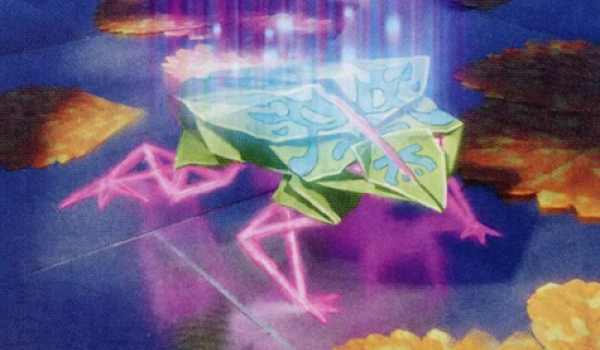Are you a Quiet Speculation member?
If not, now is a perfect time to join up! Our powerful tools, breaking-news analysis, and exclusive Discord channel will make sure you stay up to date and ahead of the curve.
Commons will always be the most consistent element of a Limited format. They create predictable openings and familiar exchanges. They communicate the terms of engagement that define the give and take of a format. They create the rhythm of the format.
As we discussed last week, March of the Machine (MOM) is a "prince" format. It has more rares and uncommons than most sets due to the Multiverse Legend and Battle slots and, as a result, the format has a heightened power level, annunciated loudest at higher rarities. These powerful cards exist, however, in a landscape crafted by commons.
To maximize the power of our rares and uncommons, we need to understand what the commons are doing at a fundamental level. Many of the rares are strong, but deck configuration helps us optimize these cards. There is a clear difference between hoping to draw good cards and building a deck that uses those game pieces in a powerful way.
Today, we'll closely examine the dynamic between commons and higher-rarity cards in MOM Draft.
UW: Utility Creatures
The small creatures in this format offer a lot of utility. This is especially true in UW. They ramp out convoke cards and utilize Knight synergies. Many of these small, flexible game pieces are at common to provide pressure and synergy, occasionally flipping into threats.
If our plan is to convoke, then we need to prioritize one-drops. In the right deck, Tarkir Duneshaper // Burnished Dunestomper plays like Llanowar Elves in the early game, and a 4/3 trampler in the late game. That's a powerful card, but it only does those things in the right deck.
UW rhythm
Raff, Weatherlight Stalwart and Baral, Chief of Compliance can both turbo-charge the convoke decks. Marshal of Zhalfir wants to use our creatures to attack. However, without the enablers, all these powerful pieces will fail to generate their game-warping power.
UW variation
Halo Hopper has been a surprising overperformer. This little frog can come down on turn two with as few as one or as many as three one-mana creatures, as well as be a free spell on turn three after a timely Preening Champion or Sigiled Sentinel.
Convoke in Practice
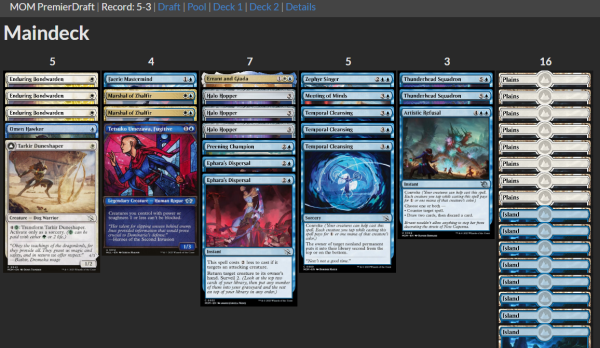
UW Convoke (5-3)
Here's a different take on UW aggro. Halo Hopper helps build a wide aggressive board, and the discounted convoke cards finish off opponents.
Thunderhead Squadron was a little too clunky. Going forward I'd like to try Astral Wings or Tidal Terror in its place. Omen Hawker probably didn't need to be in this deck. The Marshals were underutilized. I tinkered with the build a few times yet struggled with a final list.
The frog, however, is real:
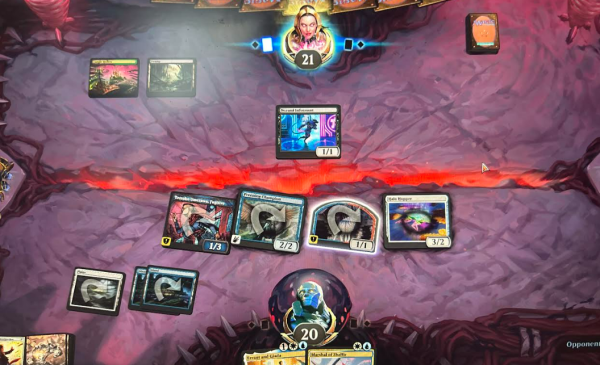
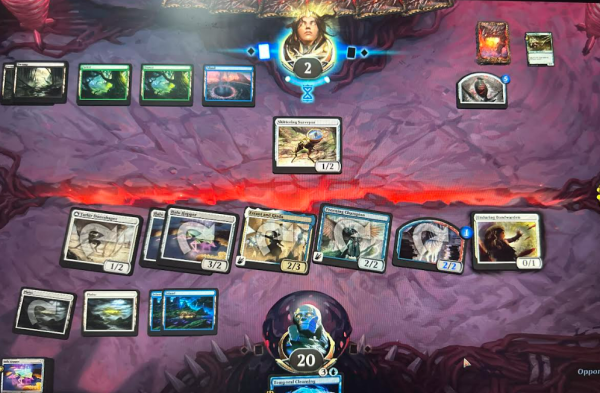
This UW strategy, turbo-charged by Halo Hopper, is quite powerful. If we can find tools to capitalize, this deck becomes a sneaky way to approach the format. Frog aside, the little creatures are important to the format, especially in UW.
BR: Sacrifice and Rectangle Theory
The UW creatures offer versatility. The BR creatures generate value. Cheap creatures in these colors thrive at trading off with a card and potentially leaving behind value. If we can capitalize on that extra bit of value, we can leverage it into big gains.
BR rhythm
Ethan Saks describes this as rectangle theory. The approach values the number of "rectangles" a card generates. This can mean tokens or other fungible game pieces. It's the reason why Lingering Souls saw play in Modern. The more game pieces we generate, the more options we have.
Wizards has labeled this strategy as Sacrifice Control, which is a novel approach to BR's perennial sacrifice theme. While the commons encourage this type of deck, the uncommons dictate what it might look like.
BR variation
The "steal and sac" principles traditionally make for aggressive gameplay, but a lot of the payoffs in this color ask us to move at a slower pace. While the commons provide excellent fodder, the uncommons will cause us to either lean more aggressive or defensive. If we're sacrificing Nezumi Informant after blocks to make an Incubate token or to draw a card, we're playing on a more value-driven spectrum. If the card we're sacrificing is dealing damage with Judith, the Scourge Diva or Juri, Master of the Revue, our deck will be more controlling.
Sacrifice in Practice
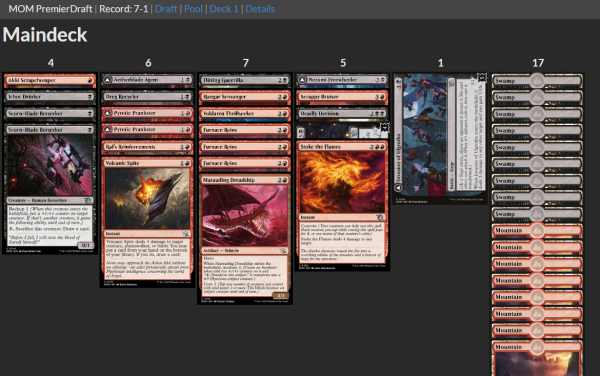
BR Sacrifice (7-1)
This deck casts many of the BR commons to generate small advantages and then utilizes them with sacrifice synergies. While Dreg Recycler and Scorn-Blade Berserker aren't game-enders, they generate a good amount of advantage that aggressive decks can leverage towards victory. The commons pressure opponents well, but also generate value. These effects allow us to keep pressuring until we can cobble together lethal.
While that general strategy is familiar to the Rakdos deck in this format, this deck gets a unique edge from three copies of Furnace Reins. This powerful effect often represented damage and a removal spell. Cards like Juri, Master of the Revue and Judith, the Scourge Diva similarly boost this style of aggression.
However, if we end up with cards like Sheoldred or Phyrexian Garagantua, our gameplan changes. In those cases, we want to prioritize cards like Nezumi Informant or Unseal the Necropolis to grind longer without reach. While the BR small-ball two-for-one engine is consistent, we want to be selective as to how we support our payoffs.
UB: Value and Power
UB is the best color combination in the format. It has been the best combination since the opening weeks. UB generates value more slowly than the other colors, but the format allows this slower approach. The payoff is power.
UB rhythm
These cards all want to play a longer game. They want us to generate cards and use more mana over more turns to overpower our opponents. The format has a lot of interaction at common, and the marriage of card draw and removal spells is timeless. Of all the archetypes in the format, this one is hungriest for payoffs.
Slower decks actively seek top-end power. The longer a game goes, the more of our deck we're going to see. If we plan on seeing a lot of our deck, we want to be confident that it will yield more powerful draws than our opponent can take on.
UB variation
The commons are more interchangeable in this archetype. They draw cards, interact, and prolong the game. However, we still want to optimize our decks around our key cards. Corruption of Towashi wants Incubate tokens and Battles. Grimgrin, Corpse-Born does not.
Nearly all of our big, bomb-y creatures appreciate a Saiba Cryptomancer for protection. Additionally, any of these potent creatures make Unseal the Necropolis skyrocket in value.
Conversely, Halo Forager and Chrome Host Seedshark both want spells, while Breach the Multiverse wants Halo-Charged Skaab to loop its effect. These cards play well together, but to support them could mean cutting something like Nezumi Freewheeler. Don't be afraid to!
UB Value in Practice
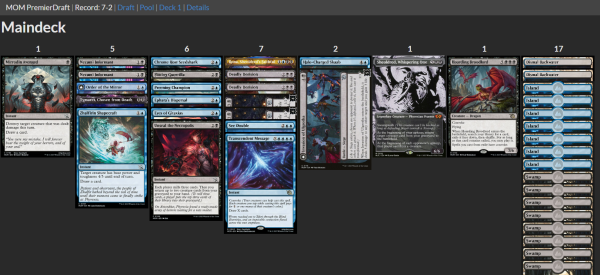
UB Busted (7-2)
UB wants commons that say "draw a card," removal, and a strong end game. In general, these decks are looking to play as many powerful things as they can.
In the above case, if my opponent and I were to flip our decks over, we were likely to agree that mine was more powerful. That's how I won, and this is a totally valid strategy in the format. There was some tension between the convoke cards and Chrome Host Seedshark. Cheap creatures help with convoke, but the Shark wants spells. Fortunately, Eyes of Gitaxias, See Double, and Unseal the Necropolis did a nice job tying the room together.
However, it's worth mentioning what I was doing early. Mirrodin Avenged and Zhalfirin Shapecraft helped to make better trades while digging deeper into the deck. The Informants traded off. It proved less important what they traded for. I just wanted the resource.
These cards prevent us from falling behind. From the very beginning of the game, we're looking to grind down our opponents. When we land something like Invasion of Eldraine // Prickle Faeries, the path opens for one of our bombs.
Maximizing Mana
Because the commons in this format don't incentivize aggression, splashing is better than usual. However, not all fixers are created equal. The power in the format can be tempting, so we should be willing to speculate on the gain lands at common.
While we have options for splashing, we want to remain cognizant of our build. Some of the fixers go from unplayable to reasonable options depending on how we're building our decks.
It's hard not to smile when we see this card late in the pack. Colorless fixing is a gift in this format, and the many small-creature strategies want extra bodies. We can speculate on this early. It will usually make the cut.
This is a powerful option that can fix for double-pipped cards like Ghalta and Mavren or Kolga and Yidaro. It's a powerful combo with Portent Tracker, and the duo can do some silly things if our draw lines up.
This little moped is more playable than it looks. Because so many of the cards offer little bodies plus value, an extra way to utilize those bodies can be worth its weight in gold. Especially if we're managing an ambitious mana base. This card does a not-terrible Citanul Stalwart impression, and sometimes we're okay with that. This is a card we should anticipate picking up on the wheel.
This is the weakest piece of fixing in the set in draft. However, in Sealed, it can be quite solid. Having access to a late-game piece of removal is nice when our opponents are less synergistic. Still, in Draft, we can get a little more out of it with Omen Hawker or Lurrus of the Dream-Den. We should still generally look for superior options.
Balancing Rhythm and Variation
This limited format has more payoffs than most. Whether we're thinking about maximizing a bomb rare, optimizing our mana, or getting the most out of our convoke creatures, card values fluctuate throughout the draft.

At common, the format offers predictable options. They may seem unexciting when compared to the Multiverse Legend we first-picked, the rare we got second, and the battle we were passed third. However, making the right choices at common to optimize those selections is the difference between having a good deck and hoping to draw a bomb.
Don't get it twisted: this is indeed a prince format. But that doesn't mean we're completely at the mercy of the draft. This game offers a great deal of autonomy. To take ownership of our draft, we need to know what the commons offer on a fundamental level. By capitalizing on these strategic edges, we can make our uncommons play like rares and our rares feel unbeatable.
As the format changes, and we transition to March of the Machine: The Aftermath (MAT), we will be tempted by new rares and uncommons. Still, all of the commons remain unchanged. This means the fundamentals of this format will be the same. Same rhythm, different variations. While evaluating the new cards, reflect on what this format offers at common. There's plenty of interaction and a lot of little value creatures. They're not going anywhere, so consider them carefully and use them well.


